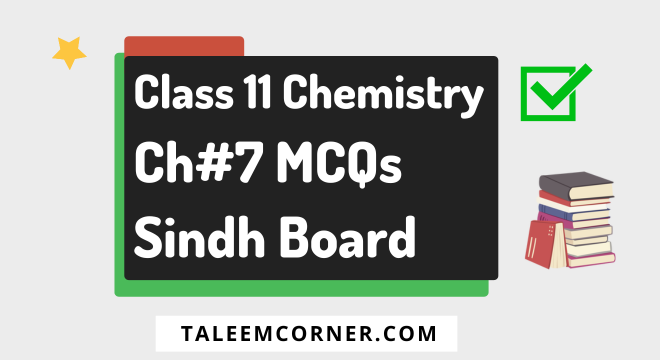Here you can prepare class 11 chemistry chapter 7 solution and electrolytes solved MCQs for Sindh board students that will be beneficial in exam paper preparation.
11 Class Chemistry Chapter 7 MCQs with Answer
These 1st-year chemistry chapter 7 MCQs are also helpful for Karachi, Hyderabad, Larkana, and Sukkur students in their Sindh Board Examination.

You May Also Like More 11th Class Chemistry MCQs:
1. The difference of pKa values for HCl and Hl is two. It means:
a) HCl is 100 times stronger than Hl
b) HCl is 10 times stronger than Hl
c) Hl is 2 times stronger than HCl
d) Hl is 100 times stronger than HCl
Answer: d) Hl is 100 times stronger than HCl
2. The electron being rich in electron and has negative charge is:
a) Anode
b) Cathode
c) Both
d) None of the above
Answer: b) Cathode
3. Graphite is an inert electrode. When the electrolysis of aqueous solution of NaCl is carried out by using graphite electrode, then the substance collected at the cathode is:
a) Hydrogen gas
b) Sodium metal
c) Sodium hydroxide
d) Chlorine gas
Answer: a) Hydrogen gas
4. ________ is that potential which is developed when the electrode of an element is in contact with the solution of its own ions.
a) Gravitational potential
b) Hydro potential
c) Electrode potential
d) None of the above
Answer: c) Electrode potential
5. Stronger the oxidizing agent, greater is the:
a) Oxidation potential
b) Reduction potential
c) Redox potential
d) E.M.F of cell
Answer: b) Reduction potential
6. The reduction potential of Zn is:
a) #ERROR!
b) -0.34V
c) #ERROR!
d) -0.6
Answer: b) -0.34V
7. ____________ is the species that reduces a substance by donating electrons to it.
a) Reducing agent
b) Oxidizing agent
c) Both of the above
d) None of the above
Answer: a) Reducing agent
8. __________ is the species that oxidizes substance by taking electrons from it.
a) Reducing agent
b) Oxidizing agent
c) Both of the above
d) None of the above
Answer: b) Oxidizing agent
9. Oxidizing agent itself gets reduced while the reducing agent gets oxidized.
a) TRUE
b) FALSE
Answer: a) TRUE
10. Non-metals are _____.
a) Reducing agent
b) Oxidizing agent
c) Both of the above
d) None of the above
Answer: b) Oxidizing agent
11. Metals are good reducing agents because they have a tendency to ___________.
a) Accept electrons
b) Lose electrons
c) Both of the above
d) None of the above
Answer: b) Lose electrons
12. pH scale ranges from ___________.
a) 0 to 10
b) 10 to 14
c) 1 to 14
d) 0 to 14
Answer: d) 0 to 14
13. If a liquid has a pH of 7 then it must.
a) be a colorless and odorless liquid
b) freeze at 0o and boils at 100oC
c) be neutral
d) be a solution containing water
Answer: c) be neutral
14. Concentration of ____________ in pure water is the basis for Ph scale.
a) Oxygen ions
b) Nitrogen ion
c) Hydrogen ion
d) none of the above
Answer: c) Hydrogen ion
15. The solutions having pH above 7 are:
a) Acidic
b) Neutral
c) Basic
d) None of the above
Answer: c) Basic
16. Common indicator for pH
a) Methyl orange
b) Litmus
c) Phenolphthalein
d) All of the above
Answer: b) Litmus
17. A buffer solution of NH4OH and NH4Cl is diluted with water to a small extent. The pH of buffer solution.
a) Increases
b) Decreases
c) Remains same
d) None of the above
Answer: c) Remains same
18. The number of moles of acid or base required by one dm3 of buffer to alter its pH by one unit is called:
a) Buffer efficiency
b) Buffer capacity
c) Buffer action
d) None
Answer: b) Buffer capacity
19. A solution which resists the change of pH when a small quantity of an acid or a base is added to that is called:
a) Buffer capacity
b) Buffer solution
c) Basic buffer
d) None of the above
Answer: b) Buffer solution
Conclusion
The topic of this post is class 11 Chemistry chapter 7 solved mcqs with answers additionally we add this post to the 11th class mcqs category.